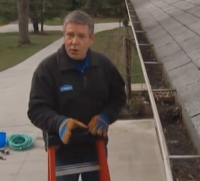Fall is right around the corner and if you haven’t done so already, now is the time to prepare your home for winter. Spending some time doing a few simple and inexpensive things will help make your home more comfortable, give you added peace of mind, and save you money on your heating bill.
The following tips will help guide you through the process. We hope you find it useful as you make your way through your fall ‘to do’ list.
Outside Your Home
Tree Trimming: Take special care to have any dead or  diseased branches removed from trees that may fall and cause injury, damage property, or take down power lines. For large trees this task is best left to the experts. Trim any trees or bushes away from the side of the house or hanging over the roof and gutters.
diseased branches removed from trees that may fall and cause injury, damage property, or take down power lines. For large trees this task is best left to the experts. Trim any trees or bushes away from the side of the house or hanging over the roof and gutters.
Chimney: Have the chimney inspected and cleaned, especially if you use a wood stove or fireplace regularly. On average, your chimney should be cleaned after every two cords of seasoned, dry wood is burned. Stock an adequate supply of dry, seasoned firewood and store away from the side of your house in a location where it will stay dry and has good air flow.
Roof and Gutters: Inspect the roof of your home and  outbuildings for any signs of leaks or damage including buckling, curling, or missing shingles. Shingles and metal flashing around chimneys, vents, and in valleys should be firmly adhered. Gutters and downspouts should be flushed and inspected.
outbuildings for any signs of leaks or damage including buckling, curling, or missing shingles. Shingles and metal flashing around chimneys, vents, and in valleys should be firmly adhered. Gutters and downspouts should be flushed and inspected.
Siding, Doors, and Windows: Take care to remove any soil or organic matter in contact with the siding. Check siding, doors, and windows for any gaps where air and moisture can pass through. Remove any old caulk and thoroughly clean areas that need repair. Allow the areas to dry completely and apply a quality, exterior caulk to seal any gaps. Check and replace worn weather stripping on all doors and windows. Install storm windows if you have them.
Outdoor Faucets: Remove, drain, and store hoses for winter. If you have an inside valve for each outdoor faucet, turn these off and open the outside faucet slightly to drain any water left in the pipes. Attach insulated covers over outside faucets. Blow out sprinkler systems.
Tools: Check that all summer tools have been cleaned and stored away for winter and that winter tools like snow shovels and blowers are accessible and ready to use.
Inside Your Home
Air Leaks: If you don’t have insulated windows you can buy inexpensive and easy to install ‘shrink & seal’ insulation kits to reduce heat loss. Changing light weight curtains with heavier drapes helps reduce heat loss and gives the room a fresh look. Add insulated plates to electrical outlets on exterior walls.
Heating System: Have a professional inspect and service your heating system each year to ensure it is operating efficiently. Replace air filters as recommended by the manufacturer. Buying a season’s worth of filters and marking your calendar in advance will help prevent overlooking this important task. Consider installing a programmable thermostat. This can save a lot of money by eliminating those times you forget to turn the heat down when leaving the house for extended periods. Walk through your home and make sure all vents or baseboard heaters are clear of furniture.
Smoke and Carbon Monoxide Detectors: Inspect all smoke and carbon monoxide detectors to ensure they are working properly. Replace batteries in each device annually or sooner if needed. Check batteries monthly at the same time you change your air filters.
Insulation: Consider having your home’s insulation inspected to ensure it meets the proper R-value specification and that there isn’t any water or rodent damage. Wrap your water heater with an insulated blanket. Wrapping exposed water pipes in the crawl space or basement and garage will cut your energy bill, as well as help prevent pipes from freezing. Be sure and check for air leaks where pipes enter the house on exterior walls and caulk or add insulation as needed.
Emergencies: Last but not least, prepare an emergency kit for you and your family in the event of a power outage or other emergency. Click here for important tips from the Red Cross and a comprehensive list of essential items to include.






 diseased branches removed from trees that may fall and cause injury, damage property, or take down power lines. For large trees this task is best left to the experts. Trim any trees or bushes away from the side of the house or hanging over the roof and gutters.
diseased branches removed from trees that may fall and cause injury, damage property, or take down power lines. For large trees this task is best left to the experts. Trim any trees or bushes away from the side of the house or hanging over the roof and gutters. outbuildings for any signs of leaks or damage including buckling, curling, or missing shingles. Shingles and metal flashing around chimneys, vents, and in valleys should be firmly adhered. Gutters and downspouts should be flushed and inspected.
outbuildings for any signs of leaks or damage including buckling, curling, or missing shingles. Shingles and metal flashing around chimneys, vents, and in valleys should be firmly adhered. Gutters and downspouts should be flushed and inspected.
